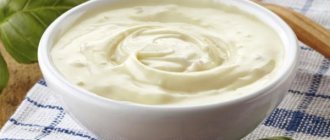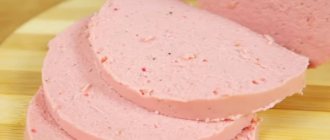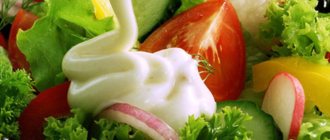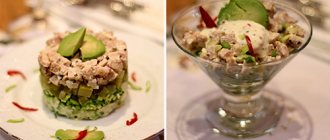Calorie content of mayonnaise 1 teaspoon
Mayonnaise increases a person's appetite and improves the taste of dishes. But doctors recommend reducing your consumption of industrial sauce, as it contains harmful chemical additives.
100 grams of classic mayonnaise contains about 600 calories, so it should not be eaten by people prone to gaining excess weight. Its regular use provokes stomach and liver diseases, worsens the condition of human skin and leads to obesity.
As an alternative to harmful sauce, you can make your own homemade mayonnaise from natural ingredients.
WEIGHT LOSS STORIES OF STARS!
Irina Pegova shocked everyone with her weight loss recipe: “I lost 27 kg and continue to lose weight, I just brew it at night. ” Read more >>
Mayonnaise sold on store shelves is high in fat. Therefore, doctors recommend strictly limiting its use.
1 tablespoon of mayonnaise “with top” – 40 grams of product, 1 teaspoon – 12 grams.
The calorie content of mayonnaise and the content of proteins, fats and carbohydrates (BZhU) in its composition depend on the brand of the manufacturer. Therefore, to calculate the energy and nutritional value of a tablespoon and a teaspoon of sauce, you need to refer to the table below.
The table shows KBJU per 100 grams of mayonnaise.
| Product name | Squirrels | Fats | Carbohydrates | Calorie content |
| Provencal Classic | 0.3 g | 67 g | 2.5 g | 618 kcal |
| Provencal Easy | 0.3 g | 30 g | 5 g | 300 kcal |
| Sloboda Provencal | 3 g | 67 g | 2.8 g | 627 kcal |
| Sloboda Olive | 3 g | 67 g | 2.8 g | 630 kcal |
| Makheev Saladny | 0.6 g | 25 g | 2 g | 240 kcal |
| Maheev Provencal | 0.6 g | 40 g | 1.8 g | 370 kcal |
| Calve Light | 0.8 g | 25 g | 6.5 g | 254 kcal |
| Calve Extra light | 1 g | 8 g | 10 g | 110 kcal |
The harmfulness of mayonnaise to the human body is due to the ingredients included in its composition:
- To produce the sauce, refined vegetable oil is used, the processing of which produces harmful trans fats. Pregnant women should not eat such foods, because they provoke pathologies of fetal development. Scientists have proven that men who regularly eat processed foods and fast food with large amounts of mayonnaise have lower testosterone levels and worsened sperm quality.
- Flavorings and flavor enhancers are addictive and increase a person’s appetite. Accumulating in the body, they lead to gastrointestinal disorders. The disease is characterized by pain in the stomach, nausea, vomiting and flatulence. In children, fragrances may cause allergic reaction symptoms.
- Preservatives extend the shelf life of mayonnaise and prevent the appearance of dangerous microorganisms in the sauce. They provoke intestinal upset, negatively affect the nervous system and lead to the formation of kidney stones.
- Synthetic emulsifiers are used in the process of preparing mayonnaise to give it a uniform consistency. They provoke inflammatory processes in the kidneys, increase cholesterol levels in the blood and disrupt the functioning of the cardiovascular system.
It is worth noting that more and more manufacturers do not add artificial colors, preservatives and flavors to mayonnaise. Before purchasing, you should familiarize yourself with the composition of the product and the expiration date (the shorter it is, the better).
Homemade mayonnaise contains natural ingredients, the moderate consumption of which does not harm human health. It can be eaten by both adults and children.
Homemade sauce components and their beneficial properties:
- Chicken eggs are easily digested by the body, so eating them does not lead to gaining extra pounds. The chemical composition of the product includes vitamins A, B1, PP, K, as well as minerals: calcium, potassium and iron. Eggs help speed up metabolism, cleanse blood vessels and develop mental abilities.
- Lemon juice is a valuable source of vitamins necessary for the normal functioning of the body. Vitamin C in its composition strengthens the walls of blood vessels and improves immunity.
- Vegetable oil contains fatty acids that maintain the strength of blood vessels and prevent the accumulation of fat in the liver tissue. The oil also protects the gastric mucosa.
- Mustard improves the taste of homemade mayonnaise and makes protein foods easier to digest. The seasoning can be eaten by people who are on a strict diet or follow the principles of proper nutrition (PN), as it activates metabolism and promotes the breakdown of fats.
Homemade mayonnaise is a healthy and tasty alternative to industrial sauce. You can season it with Olivier salad, herring under a fur coat, vegetable salad, or use it separately as a sauce for main dishes. Below are two popular recipes that take no more than five minutes to prepare.
To prepare the classic sauce you will need the following ingredients:
- chicken egg – 1 pc. ;
- lemon – 1/2 pcs.;
- refined vegetable oil – 300 ml;
- salt – 1/2 tsp;
- granulated sugar – 1 tsp;
- mustard – 1/2 tsp;
- ground black pepper – 1/4 tsp.
- 1. Break a chicken egg into a bowl. Add spices and vegetable oil to it.
- 2. Squeeze the juice from half a lemon and add it to the rest of the ingredients.
- 3. Using an immersion blender, beat the mixture until smooth and fluffy. It will take 40-60 seconds to beat. Transfer the finished mayonnaise into a convenient container and store it in the refrigerator.
The Mediterranean people use Alioli sauce as a dressing for fish dishes and salads. To prepare it you will need:
- garlic – 2 cloves;
- chicken egg – 1 pc.;
- refined olive oil – 200 ml;
- salt - to taste.
- 1. Peel the garlic, cut into four parts and place in a bowl.
- 2. Add the egg, butter and a pinch of salt.
- 3. Using a blender, beat all ingredients well. Spanish mayonnaise is ready.
And a little about secrets
The story of one of our readers Alina R.:
I was especially depressed about my weight. I gained a lot, after pregnancy I weighed as much as 3 sumo wrestlers together, namely 92 kg with a height of 165. I thought the belly would go away after giving birth, but no, on the contrary, I began to gain weight.
How to cope with hormonal changes and obesity? But nothing disfigures or makes a person look younger than his figure. At the age of 20, I first learned that plump girls are called “WOMAN”, and that “they don’t make clothes that size.”
Then at the age of 29, divorce from my husband and depression.
And when will you find time for all this? And it's still very expensive. Especially now. Therefore, I chose a different method for myself.
How many calories are in one teaspoon of mayonnaise?
How many calories are in one teaspoon of mayonnaise??
Although a teaspoon contains very little mayonnaise - only 5 grams, but due to its high calorie content, it turns out not so few calories. This is worth considering for those who want to reduce the calorie content of, for example, salad.
The calorie content of this product is within 600 kcal. This is a lot, but mayonnaise contains vegetable oil, so this is not surprising.
Now let's calculate how many calories we have per 1 teaspoon.
600 kcal – 100 g
Of course, there is mayonnaise with less calories, light. Then a teaspoon will not be so dangerous for the diet)
You can replace mayonnaise, but the taste of the dish will also change.
Mayonnaise, which is sold in the store, is very high in calories, since a lot of fat is added to it and also chemical additives are added so that it is stored well, and these additives are very harmful to the body.
And in light mayonnaise, where there is less fat and its calorie content is reduced, there are even more chemical additives than in mayonnaise with high fat content, because light mayonnaise becomes tasteless due to the lack of fat and therefore flavor enhancers are added to it, which are simply dangerous for the body. That is, store-bought mayonnaise is not only too high in calories, but also harmful.
One hundred grams of mayonnaise contains 600 calories, and a teaspoon contains about five grams of mayonnaise, so after a short calculation we find that one teaspoon of mayonnaise contains 50 calories.
Source: https://vodako.ru/kalorii/kalorijnost-majoneza-1-chajnaya-lozhka
Calorie content of mayonnaise and weight loss
The calorie content of mayonnaise prepared in accordance with the traditional recipe is significant
: per 100 grams of sauce there are about 600 kcal. There is low-calorie mayonnaise, but it is important to understand that it contains many harmful ingredients, so consuming this product is undesirable, and people trying to lose weight should completely eliminate it from their diet.
If you are trying to get rid of extra pounds, but do not want to give up your favorite sauce, it is recommended to prepare its homemade low-calorie analogue.
When choosing mayonnaise, you must be guided by a number of criteria. First, you need to pay attention to the quality standard. A product produced in accordance with GOST is of higher quality than one produced in accordance with specifications. Secondly, you should not save: a low price indicates that the sauce does not contain natural products. The lower the fat content, the more emulsifiers and stabilizers are included in the mayonnaise.
Harm, calorie content of mayonnaise per 100 grams. Mayonnaise – 1 teaspoon (4.8g)
Calorie content of beets with garlic and mayonnaise per 100 grams is 122.3 kcal. A 100-gram serving of salad contains 2.1 g of protein, 8.1 g of fat, and 10.3 g of carbohydrates.
Read: Calorie content of Lays chips per 100 grams
To prepare the dish you will need the following ingredients:
- 0.2 kg boiled beets;
- 10 g garlic;
- 5 g salt;
- 30 g classic mayonnaise.
Recipe:
- the beets are boiled until ready, cool, and grated;
- crushed garlic, mayonnaise and salt are added to the beets;
- All components of the dish are thoroughly mixed. Salad ready!
Calorie content of mayonnaise in 1 tablespoon
The calorie content of mayonnaise in 1 tablespoon is 156 kcal. One tablespoon of sauce contains
- 0.79 g protein;
- 16.75 g fat;
- 0.65 g carbohydrates.
Calorie content of mayonnaise in 1 teaspoon
The calorie content of mayonnaise in a teaspoon is 62.5 kcal. A teaspoon of the product contains:
- 0.31 g protein;
- 6.7 g fat;
- 0.25 g carbohydrates.
Calorie content of cabbage salad with mayonnaise per 100 grams
Calorie content of cabbage salad with mayonnaise per 100 grams is 85 kcal. 100 g of dish contains:
- 1.84 g protein;
- 6.7 g fat;
- 4.25 g carbohydrates.
Read: Calorie content of baklava per 100 grams
For preparation you need 90 g of fresh white cabbage and 10 g of classic mayonnaise. The cabbage is chopped, salted (salt is added to taste), seasoned with mayonnaise and mixed thoroughly.
Calorie content of salad of tomatoes, cucumbers and mayonnaise per 100 grams
The calorie content of a salad of tomatoes, cucumbers and mayonnaise per 100 grams is 55 kcal. 100 g of dish contains:
- 0.8 g protein;
- 4.25 g fat;
- 3.5 g carbohydrates.
The following ingredients are required for preparation:
- 0.32 kg of tomatoes;
- 0.25 kg of cucumbers;
- 40 g traditional mayonnaise;
- 2 g salt.
Recipe:
- cucumbers and tomatoes are cut into small slices;
- vegetables are placed in a bowl, salted, seasoned with mayonnaise and mixed thoroughly. The dish is ready to eat!
Calorie content of carrots with garlic and mayonnaise per 100 grams
Calorie content of carrots with garlic and mayonnaise per 100 grams is 109 kcal. 100 g of salad contains 1.69 g of protein, 8.57 g of fat, 7.28 g of carbohydrates. Recipe:
- 0.2 kg of carrots grated;
- squeeze out 10 g of garlic;
- grated carrots are mixed with garlic and seasoned with 30 g of mayonnaise. All salad components are mixed.
Calorie content of mayonnaise with egg per 100 grams
Calorie content of mayonnaise with egg per 100 grams is 192 kcal. 100 g of product contains 9.45 g of protein, 16.1 g of fat, 2.1 g of carbohydrates.
To prepare one 76-gram serving you need 2 eggs and 40 g of traditional mayonnaise. The eggs are boiled, cut in half, placed on a plate and spread with mayonnaise on top. Before eating, cool the finished dish for 10 minutes in the refrigerator.
Calorie content of herring under a fur coat with mayonnaise per 100 grams
Calorie content of herring under a fur coat with mayonnaise per 100 grams is 116 kcal. A 100-gram serving of the dish contains 5.15 g of protein, 6.25 g of fat, and 9.3 g of carbohydrates. In addition to mayonnaise, to prepare herring under a fur coat you need boiled beets, boiled carrots, onions, boiled potatoes, salted herring, and an egg.
Calorie content of homemade mayonnaise per 100 grams
The calorie content of homemade mayonnaise per 100 grams is 444 kcal. 100 g of product contains:
- 4.52 g protein;
- 35.4 g fat;
- 26.3 g carbohydrates.
Read: Calorie content of vinaigrette with vegetable oil and potatoes
Recipe:
- In 2 chicken eggs, the yolks are separated, they are placed in a blender and beaten until thick with half a teaspoon of mustard, 2 g of salt and half a tablespoon of sugar;
- while beating, vegetable oil is slowly added to the resulting yolk mixture (the total volume of vegetable oil should not be more than 100 ml);
- Add 1 tablespoon of lemon juice to the prepared homemade mayonnaise. The sauce is thoroughly mixed.
Calorie content of lean mayonnaise per 100 grams
The calorie content of lean mayonnaise per 100 grams is 293 kcal. 100 g of sauce contains:
- 1.2 g protein;
- 30 g fat;
- 4 g carbohydrates.
If you want to lose weight, but cannot give up mayonnaise, we advise you to switch to a lean product. This sauce is characterized by 2 times less fat content.
Calorie content of light mayonnaise per 100 grams
The calorie content of light mayonnaise per 100 grams is 298 kcal. 100 g of product contains:
- 0.32 g protein;
- 30 g fat;
- 5.18 g carbohydrates.
A special feature of light mayonnaise is its low fat content. According to GOST requirements, the mass fraction of fat in the product should not exceed 25 - 30%.
Calorie content of cheese with garlic and mayonnaise per 100 grams
Calorie content of cheese with egg, garlic and mayonnaise per 100 grams is 352 kcal. A 100-gram serving of the dish contains:
- 20.7 g protein;
- 29 g fat;
- 1.35 g carbohydrates.
Recipe:
- 0.3 kg of hard cheese is grated and placed in a bowl;
- cheese is mixed with one grated boiled egg;
- Squeeze 3 cloves of garlic into the resulting mixture;
- add 50 g of classic mayonnaise to the salad;
- All components of the dish are thoroughly mixed.
Other foods with about 302 calories:
Tomato powder Chicken Hamburger Egg and Pork Cutlet Bagel Agave Syrup Cinnamon Roll Dried Cranberries Fried Sausage Pork Knuckle Dill Leaves Baked Plantain
Calorie counter
Mayonnaise – 1 teaspoon – burn calories
Your weight: lbs Running (8 km/h) 2 min. 2.432.031.741.521.351.221.111.01 Walking (6 km/h) 3 min. 4.503.753.212.812.502.251.881.73 Bicycle 2 min. 31.020. 94 Swimming (25 m/min) 3min.3.753.122.682.342.081.881.721.56 Aerobika3min. 3.923.262.792.452.171.
Product nutrients (details)
Chemical composition and nutritional value of mayonnaise Calories Vitamins Amino acids Minerals
Squirrels
Fats
Carbohydrates
Finally, some useful tips
- Mayonnaise made from quail eggs is more delicate and healthy.
- Raw egg sauce requires careful quality control - make sure the eggs are fresh.
- It is believed that olive oil is better than others, but in this case the sauce may be bitter. Therefore, it is worth taking part olive and part sunflower oil.
- You can use good vinegar instead of lemon juice.
- If mayonnaise is too thick, add a teaspoon of water (or 2 tsp) and beat it again.
Source: https://tuberkulezkin.ru/diety/majonez-kalorijnost-na-100-gramm-i-vred.html
How many grams of mayonnaise are in a teaspoon?
One teaspoon contains 15 heaped grams of mayonnaise.
1 teaspoon contains 10 grams of mayonnaise without a slide.
Calorie content of 1 spoon of mayonnaise (table and tea)
A level tablespoon of mayonnaise contains 170 calories.
A level teaspoon of mayonnaise contains 68 calories.
Note: the calorie content of mayonnaise depends on its fat content, so the number of calories in a spoonful of mayonnaise can vary greatly if you use low-fat and, conversely, very fatty mayonnaise. In the calculations, we took regular medium-fat mayonnaise, the calorie content of which is 680 calories per 100 grams of product.
Answers to popular questions, how to measure mayonnaise in grams without scales using spoons
Many recipes and dishes often require the same amount of an ingredient such as mayonnaise, and in order not to calculate each time how many tablespoons or teaspoons of mayonnaise are needed, we have made ready-made calculations for you:
- 300 grams of mayonnaise - how many tablespoons? 300 g mayonnaise = 12 level tablespoons of mayonnaise.
- 250 grams of mayonnaise - how many tablespoons? 250 g mayonnaise = 10 level tablespoons of mayonnaise.
- 200 grams of mayonnaise - how many tablespoons? 200 g mayonnaise = 8 level tablespoons of mayonnaise.
- 150 grams of mayonnaise is how many tablespoons? 150 g mayonnaise = 6 level tablespoons of mayonnaise.
- 130 grams of mayonnaise is how many tablespoons? 130 g mayonnaise = approximately 3 heaped tablespoons of mayonnaise = 4 heaped tablespoons of mayonnaise + 2 heaped teaspoons of mayonnaise.
- 125 grams of mayonnaise is how many tablespoons? 125 g mayonnaise = 5 level tablespoons of mayonnaise.
- 100 grams of mayonnaise - how many tablespoons? 100 g mayonnaise = 4 level tablespoons of mayonnaise.
- 90 grams of mayonnaise is how many tablespoons? 90 g mayonnaise = 2 heaped tablespoons of mayonnaise.
- 70 grams of mayonnaise is how many tablespoons? 70 g mayonnaise = 2 tablespoons mayonnaise without a slide + 2 teaspoons mayonnaise without a slide.
- 50 grams of mayonnaise is how many tablespoons? 50 g mayonnaise = 2 level tablespoons of mayonnaise.
- 40 grams of mayonnaise - how many spoons? 40 g mayonnaise = 1 level tablespoon of mayonnaise + 1 heaped teaspoon of mayonnaise.
- 30 grams of mayonnaise – how many spoons? 30 g mayonnaise = 2 heaped teaspoons of mayonnaise.
- 25 grams of mayonnaise - how many spoons? 25 g mayonnaise = 1 heaped teaspoon of mayonnaise + 1 heaped teaspoon of mayonnaise.
- 20 grams of mayonnaise - how many spoons? 20 g mayonnaise = 2 level teaspoons of mayonnaise.
We also read articles
Harm, calorie content of mayonnaise per 100 grams
> Calorie content, benefits, harm of products > Sauces, spices > Harm, calorie content of mayonnaise per 100 grams
Calorie content of mayonnaise 67% per 100 grams 625 kcal. 100 g of product contains:
- 3.15 g protein;
- 67 g fat;
- 2.59 g carbohydrates.
Traditional mayonnaise contains vitamins A, E, B1, B2, PP, minerals calcium, phosphorus, potassium, magnesium, sodium, iron. The product contains mustard, vegetable or olive oil, egg yolks, salt, lemon juice, sugar.
Calorie content of beets with mayonnaise and garlic per 100 grams
Calorie content of beets with garlic and mayonnaise per 100 grams is 122.3 kcal. A 100-gram serving of salad contains 2.1 g of protein, 8.1 g of fat, and 10.3 g of carbohydrates.
Read: Calorie content of Lays chips per 100 grams
To prepare the dish you will need the following ingredients:
- 0.2 kg boiled beets;
- 10 g garlic;
- 5 g salt;
- 30 g classic mayonnaise.
Recipe:
- the beets are boiled until ready, cool, and grated;
- crushed garlic, mayonnaise and salt are added to the beets;
- All components of the dish are thoroughly mixed. Salad ready!
The harm of mayonnaise
The following harms of mayonnaise have been proven:
- the product is saturated with fats, the processing of which creates a large burden on the liver and pancreas;
- Not only classic but also low-fat types of mayonnaise are harmful to health. Such suos use modified vegetable oils (trans fats), which are obtained as a result of chemical processing of natural vegetable oils;
- if you regularly eat mayonnaise, skin problems arise;
- the product provokes atherosclerosis, metabolic disorders, obesity;
- mayonnaise cholesterol causes vascular and heart diseases;
- due to the considerable amount of salt in the composition, mayonnaise is contraindicated in those with a tendency to edema, impaired water balance, or high blood pressure;
- The high calorie content of mayonnaise does not allow the use of this product when losing weight and during diets.
SUBSCRIBE TO SITE UPDATES
By clicking the button, I agree to the newsletter, the processing of personal data and accept the privacy policy.
Source: https://horoshieprivychki.ru/kalorijnost/majonez-kalorijnost
The harm of mayonnaise
The following harms of mayonnaise have been proven:
- the product is saturated with fats, the processing of which creates a large burden on the liver and pancreas;
- Not only classic but also low-fat types of mayonnaise are harmful to health. Such suos use modified vegetable oils (trans fats), which are obtained as a result of chemical processing of natural vegetable oils;
- if you regularly eat mayonnaise, skin problems arise;
- the product provokes atherosclerosis, metabolic disorders, obesity;
- mayonnaise cholesterol causes vascular and heart diseases;
- due to the considerable amount of salt in the composition, mayonnaise is contraindicated in those with a tendency to edema, impaired water balance, or high blood pressure;
- The high calorie content of mayonnaise does not allow the use of this product when losing weight and during diets.
Mayonnaise was invented by a chef by culinary “accident,” as an experiment with available products, like many simple and at the same time ingenious dishes. Mayonnaise is a favorite sauce of many people, but for those who are on a diet
, it is a prohibited product due to its
high calorie content
. But not everyone decides to completely give up mayonnaise, and therefore many “light” versions arise.
The classic version of mayonnaise contains the following ingredients: vegetable oil, citric acid or vinegar, egg powder (or eggs). Most people prefer to buy a ready-made version of this sauce rather than making it themselves. This is due to the fact that store-bought mayonnaise lasts much longer.
Of course, mayonnaise prepared independently
very
short
shelf life when compared with the purchased version, but it is more
natural
than a product from
a store
, which contains many different additives
, preservatives
and
flavor enhancers
.
And if we analyze in detail the composition of homemade and purchased mayonnaise, then there are fewer calories in the homemade version of the sauce
, and besides, all the ingredients are known, while the manufacturer can leave a lot unsaid and hide some components of non-vegetable origin.
Calorie content of mayonnaise
| calorie content per 100 g | calorie content of 1 teaspoon (12 g) | calorie content of 1 tablespoon (30 g) | |
| Calorie content of classic mayonnaise | 618 | 74,16 | 185,4 |
| Calorie content of homemade mayonnaise | 615 | 73,8 | 184,5 |
| Calorie content of light mayonnaise | 299 | 35,88 | 89,7 |
| Calorie content of quail egg mayonnaise | 616 | 73,92 | 184,8 |
| Calorie content of Japanese mayonnaise | 134 | 16,08 | 40,2 |
| Calorie content of Provencal mayonnaise | 624 | 74,88 | 187,2 |
| Calorie content of dietary mayonnaise | 204 | 24,48 | 61,2 |
| Calorie content of fitness mayonnaise | 84 | 10,08 | 25,2 |
The benefits of mayonnaise
Despite the main disadvantage of mayonnaise - its calorie content, it also has beneficial effects on the body.
, of course, if the composition is transparent. Mayonnaise is useful due to the following properties:
- promotes the production of gastric juice
; - the oil content will saturate the body with essential vitamins E, F and beta-carotene
; - lecithin will have a beneficial effect on the liver
and
nervous system
; - mayonnaise will compensate for the lack of vitamins PP, A and
B.
The harm of mayonnaise
Should be abandoned
from mayonnaise for people suffering from
stomach and intestinal diseases
.
If you choose a low-calorie product
, it is important to understand that it contains many different
harmful additives
, emulsifiers and stabilizers, much more than in the classic version. For those who are on a diet or who need to lose weight for health reasons, it is better to abstain from mayonnaise.
If you prefer to buy mayonnaise rather than prepare it yourself, you should pay attention to the manufacturers
that
you trust
and remember that
high -quality mayonnaise will not be cheap
.
Calorie content of salads with mayonnaise
Homemade mayonnaise recipe
Anyone who can afford to treat themselves to mayonnaise should stick to the homemade version.
and get into the habit of making mayonnaise yourself -
the taste
will be
delicious
, and
the quality of the ingredients will be the best
: high in calories, but healthy.
For homemade mayonnaise you will need:
- 3 yolks (raw)
- vegetable oil (olive) - 180 ml;
- salt;
- sugar - 15 g;
- mustard - 10 g;
- apple cider vinegar - 12 ml.
Mix all the ingredients except the oil into a homogeneous mass, continue whisking, and pour in the oil in a thin stream. It only takes 10-15 minutes to prepare homemade mayonnaise.
Mayonnaise is a product that, according to the website fotodiet.ru, is unjustifiably widely used in our kitchen. It allows you to hide the housewife’s flaws, but at the same time, it also hides the true taste of the food. In addition, it is harmful to health. This is especially true for store-bought products. The vast majority of mayonnaise on our shelves is not made from natural products. Vegetable oil is replaced with synthetic trans fats, an emulsifier, flavor enhancers, and preservatives are added, and the result is a completely chemical product that causes only one harm.
Moreover, the calorie content of such a product is close to the calorie content of fats and vegetable oils. So regular Provencal mayonnaise contains 500 calories in 100 grams, and homemade mayonnaise contains more than 600 calories.
Therefore, if your health is important to you, mayonnaise has no place on your table. Well, for the holiday, make your own mayonnaise using an old homemade recipe.
Homemade mayonnaise recipe:
You'll need:
Chicken egg - 4 pcs. Olive oil - ½ liter. Sugar - 1 teaspoon. Salt - 2 teaspoons. Mustard - 2 teaspoons. Wine vinegar 3% - 2 tbsp. spoons. Ground black pepper.
To prepare, carefully separate the egg yolks and whisk them thoroughly with mustard, salt and pepper. Beat by hand, rotating the whisk in the same direction, adding a drop of vegetable oil.
After about 1/3 of the oil has been added to the sauce, it can be poured in in a thin stream.
After adding all the oil, the mass becomes homogeneous, thickens and begins to lag behind the walls of the bowl.
To give the sauce the necessary spiciness, 3% wine vinegar is added, after which the mass turns white and the mayonnaise is ready. The shelf life of this product is only 72 hours.
How many calories are in mayonnaise - store-bought and homemade?
Everything ingenious is simple. This expression helps to describe the sauce that many people love - mayonnaise. It appeared completely by accident in ancient times. During the campaign, when the cook no longer knew what to feed the military, he simply combined an egg and vegetable oil, beat until smooth and got an amazing dish. Today we are discussing how many calories are in mayonnaise.
Counting calories
The nutritional value of mayonnaise is of interest to many people, because this sauce is often added to salads, snack treats, and all kinds of main courses. Even the dough is made on a mayonnaise basis.
To accurately estimate the calorie content of mayonnaise, you need to know its fat content.
On average, the energy value of such a product will vary from 150 to 700 kilocalories per hundred gram serving.
If we are talking about mayonnaise with a minimum percentage of fat content, no more than 17%, then its nutritional value will fluctuate within 150 kilocalories. But “Provencal”, whose fat content reaches 67%, contains as much as 700 kilocalories. Agree, quite a lot!
If previously mayonnaise was prepared exclusively from natural ingredients, then in the industrial sphere the recipe has changed somewhat. Experts add a lot of preservatives, various flavor enhancers and chemical components. All this not only improves taste, but also extends shelf life. And accordingly, the question arises: is such food healthy?
But we’ll talk about this a little later, but now I would like to know how many calories are in a spoon of mayonnaise. If we are talking about a teaspoon, the weight of which is about four grams, then the calorie content of the sauce will be about 25-26 kilocalories.
Many people eat mayonnaise. Much fewer people prepare the product at home. And all because of its short storage. But, of course, in this form the sauce will be much healthier for the body. How many calories are in homemade mayonnaise? A 100-gram serving contains about 568 kilocalories.
Most of all mayonnaise, industrial or home-made, contains fat - about 70 g. But there are very few carbohydrates - no more than 0.2 g. Proteins are also contained in minimal quantities.
In addition, mayonnaise sauce contains ash, water, starch, trans fats, fiber and cholesterol. By the way, the latter is contained in considerable quantities, which is why it is contraindicated for people prone to the formation of blood clots or with high cholesterol levels.
Is there any benefit?
The vitamin and mineral composition of mayonnaise, of course, homemade, is pleasantly surprising. It is varied and helps a person compensate for the lack of necessary elements. But we should not forget for a moment about the extremely high nutritional value of the sauce, which has gained worldwide popularity.
Component composition:
- beta-carotene;
- iron;
- manganese;
- thiamine;
- retinol;
- vitamin K;
- potassium;
- folic, pantothenic acids;
- manganese;
- ascorbic acid;
- pyridoxine;
- selenium;
- vitamin D
Of course, adding all sorts of chemical compounds, preservatives, dyes, and flavor enhancers to white sauce will negate the effect of the vitamin-mineral complex.
The so-called “light” mayonnaises do much more harm than good. Yes, the nutritional value is lower compared to a classic fatty product.
But just think about what you are eating! Then no taste qualities will lure you.
As medical practice shows, mayonnaise still contains beneficial properties. But provided it is consumed in moderation.
Benefits of mayonnaise:
- stimulation of gastric juice production;
- replenishment of tocopherol and vitamin F deficiency;
- ensuring complete digestibility of food;
- stabilization of liver function;
- strengthening the nervous system.
This is probably where the beneficial properties of mayonnaise sauce end.
Important! It is not recommended for children to eat this product, especially at an early age. Mayonnaise consumption should be limited to people suffering from digestive disorders.
Preparing the “correct” mayonnaise
If you are fighting a grueling struggle with extra pounds, then we are not talking about consuming mayonnaise. This product should be completely excluded from your everyday diet. Nutritionists always advise replacing this food with low-calorie sour cream or natural yogurt. It is even better to use refined olive oil for dressing salads.
But if you still cannot deny yourself gastronomic pleasure, prepare homemade mayonnaise. A minimum of ingredients and sleight of hand will help you prepare a high-calorie, but healthy treat.
Ingredients:
- selected chicken eggs - two pieces;
- refined vegetable oil – 120 ml;
- salt – ½ teaspoon. spoons;
- freshly squeezed lemon juice - one table. spoon;
- granulated sugar - one teaspoon. spoon;
- store-bought mustard - one teaspoon. spoon.
Preparation:
- First of all, we need to separate the yolks. We do this carefully so that not even a drop of the protein mass remains.
- Transfer the egg yolks into a convenient bowl with high sides or into a container of a blender or mixer.
- Add granulated sugar.
- Add salt here.
- We introduce store-bought mustard. You can use mustard powder, which is diluted with filtered water before cooking in the indicated proportions.
- At maximum speed, beat these components thoroughly until the mass becomes homogeneous.
- Now pour in the required amount of refined vegetable oil. An olive product is ideal.
- Mix everything again. It is best to use a blender with a whisk or a mixer.
- Next up is freshly squeezed lemon juice. This component will help give your homemade sauce a white tint.
- Beat everything again for a few minutes. The mass should be perfectly uniform and light.
- Homemade mayonnaise with the addition of freshly squeezed lemon juice is incredibly tasty. It cannot be stored for a long time. Therefore, cook in small portions.
Source: https://mnogoli.ru/skolko-kalorij-v-majoneze-pokupnom-i-domashnem
How many calories are in mayonnaise
Mayonnaise increases a person's appetite and improves the taste of dishes. But doctors recommend reducing your consumption of industrial sauce, as it contains harmful chemical additives.
100 grams of classic mayonnaise contains about 600 calories, so it should not be eaten by people prone to gaining excess weight. Its regular use provokes stomach and liver diseases, worsens the condition of human skin and leads to obesity.
As an alternative to harmful sauce, you can make your own homemade mayonnaise from natural ingredients.
WEIGHT LOSS STORIES OF STARS!
Irina Pegova shocked everyone with her weight loss recipe: “I lost 27 kg and continue to lose weight, I just brew it at night. » Read more >>
Mayonnaise sold on store shelves is high in fat. Therefore, doctors recommend strictly limiting its use.
1 tablespoon of mayonnaise “with top” - 40 grams of product, 1 teaspoon - 12 grams.
The calorie content of mayonnaise and the content of proteins, fats and carbohydrates (BZhU) in its composition depend on the brand of the manufacturer. Therefore, to calculate the energy and nutritional value of a tablespoon and a teaspoon of sauce, you need to refer to the table below.
The table shows KBJU per 100 grams of mayonnaise.
The harmfulness of mayonnaise to the human body is due to the ingredients included in its composition:
- To produce the sauce, refined vegetable oil is used, the processing of which produces harmful trans fats. Pregnant women should not eat such foods, because they provoke pathologies of fetal development. Scientists have proven that men who regularly eat processed foods and fast food with large amounts of mayonnaise have lower testosterone levels and worsened sperm quality.
- Flavorings and flavor enhancers are addictive and increase a person’s appetite. Accumulating in the body, they lead to gastrointestinal disorders. The disease is characterized by pain in the stomach, nausea, vomiting and flatulence. In children, fragrances may cause allergic reaction symptoms.
- Preservatives extend the shelf life of mayonnaise and prevent the appearance of dangerous microorganisms in the sauce. They provoke intestinal upset, negatively affect the nervous system and lead to the formation of kidney stones.
- Synthetic emulsifiers are used in the process of preparing mayonnaise to give it a uniform consistency. They provoke inflammatory processes in the kidneys, increase cholesterol levels in the blood and disrupt the functioning of the cardiovascular system.
It is worth noting that more and more manufacturers do not add artificial colors, preservatives and flavors to mayonnaise. Before purchasing, you should familiarize yourself with the composition of the product and the expiration date (the shorter it is, the better).
Homemade mayonnaise contains natural ingredients, the moderate consumption of which does not harm human health. It can be eaten by both adults and children.
Homemade sauce components and their beneficial properties:
- Chicken eggs are easily digested by the body, so eating them does not lead to gaining extra pounds. The chemical composition of the product includes vitamins A, B1, PP, K, as well as minerals: calcium, potassium and iron. Eggs help speed up metabolism, cleanse blood vessels and develop mental abilities.
- Lemon juice is a valuable source of vitamins necessary for the normal functioning of the body. Vitamin C in its composition strengthens the walls of blood vessels and improves immunity.
- Vegetable oil contains fatty acids that maintain the strength of blood vessels and prevent the accumulation of fat in the liver tissue. The oil also protects the gastric mucosa.
- Mustard improves the taste of homemade mayonnaise and makes protein foods easier to digest. The seasoning can be eaten by people who are on a strict diet or follow the principles of proper nutrition (PN), as it activates metabolism and promotes the breakdown of fats.
Homemade mayonnaise is a healthy and tasty alternative to industrial sauce. You can season it with Olivier salad, herring under a fur coat, vegetable salad, or use it separately as a sauce for main dishes. Below are two popular recipes that take no more than five minutes to prepare.
To prepare the classic sauce you will need the following ingredients:
- chicken egg - 1 pc. ;
- lemon - 1/2 pcs.;
- refined vegetable oil - 300 ml;
- salt - 1/2 tsp;
- granulated sugar - 1 tsp;
- mustard - 1/2 tsp;
- ground black pepper - 1/4 tsp.
- 1. Break a chicken egg into a bowl. Add spices and vegetable oil to it.
- 2. Squeeze the juice from half a lemon and add it to the rest of the ingredients.
- 3. Using an immersion blender, beat the mixture until smooth and fluffy. It will take 40-60 seconds to beat. Transfer the finished mayonnaise into a convenient container and store it in the refrigerator.
The Mediterranean people use Alioli sauce as a dressing for fish dishes and salads. To prepare it you will need:
- garlic - 2 cloves;
- chicken egg - 1 pc.;
- refined olive oil - 200 ml;
- salt - to taste.
- 1. Peel the garlic, cut into four parts and place in a bowl.
- 2. Add the egg, butter and a pinch of salt.
- 3. Using a blender, beat all ingredients well. Spanish mayonnaise is ready.
How to make mayonnaise at home
If you want to get healthy and tasty mayonnaise, we recommend using “grandmother’s” proven recipe. For this you will need the following ingredients: raw yolks (3 pcs.), olive oil (2/3 cup), sugar (1/2 tablespoon), pinch of salt, mustard (1 teaspoon), apple cider vinegar (1/2 tablespoon spoons).
All ingredients, with the exception of oil, must be blended with a blender until a homogeneous thick mass is formed. After this, add the butter in a thin stream and continue whisking the sauce until you get the desired consistency. The calorie content of mayonnaise prepared at home is lower than its store-bought counterpart.
Mayonnaise has long become a common addition to most dishes - it is added to soups, salads, baked goods, and main courses. Many people literally cannot imagine their life without mayonnaise, it has become so firmly established in their diet. But what is mayonnaise?
Mayonnaise prepared according to the classic recipe consists of familiar and healthy products - eggs, vegetable oil, mustard, vinegar or lemon juice, salt. The main components of this sauce, to which it owes its beneficial properties, are vegetable oil and eggs, or rather, egg yolks. The higher quality these two products are, the more healthy mayonnaise will be. The healthiest mayonnaise is made from natural olive oil and quail eggs.
About 2/3 of this sauce is fat. Mayonnaise also contains carbohydrates, proteins and cholesterol. Mayonnaise contains vitamins A, PP, E, choline, B vitamins, as well as micro- and macroelements: magnesium, calcium, sodium, phosphorus, iron, etc.
The calorie content of mayonnaise depends on its fat content - the more fat, the more calories
. Unfortunately, in addition to the classic ingredients, manufacturers supplement the recipe for preparing this sauce with other additives that reduce the cost of the production process and extend the shelf life, but negatively affect the usefulness and taste of the product. Among them it is necessary to note:
- sorbic acid, potassium sorbate - a preservative, and not the safest;
- starch – it increases the weight and calorie content of mayonnaise, making it “more satisfying”;
- stabilizers (guar gum, xanthan gum) or thickeners (E1422, etc.) - make the consistency of mayonnaise thicker, without them it would be too liquid, since it is diluted with water to increase the volume;
- flavorings (for example, mustard) - few people use natural mustard;
- antioxidants – extend shelf life;
- dye (beta-carotene) - necessary to give the product a yellowish color, the only useful ingredient from the additives.
Few manufacturers use mustard or olive oil, even fewer use natural lemon juice, and there is no talk of using natural egg yolks at all - they are replaced with egg powder.
The calorie content of mayonnaise is the reason why it is contraindicated for people who are overweight
. The presence of irritating components - acid, pepper, mustard - prohibits its use by people with diseases of the gastrointestinal tract. Also, do not forget that mayonnaise contains quite a lot of cholesterol - if you have problems with the cardiovascular system, you should also avoid this product.
In the absence of contraindications and subject to moderate consumption, mayonnaise, prepared independently, is a tasty and satisfying sauce that increases appetite, helps digest certain foods and facilitates the absorption of fat-soluble vitamins.











